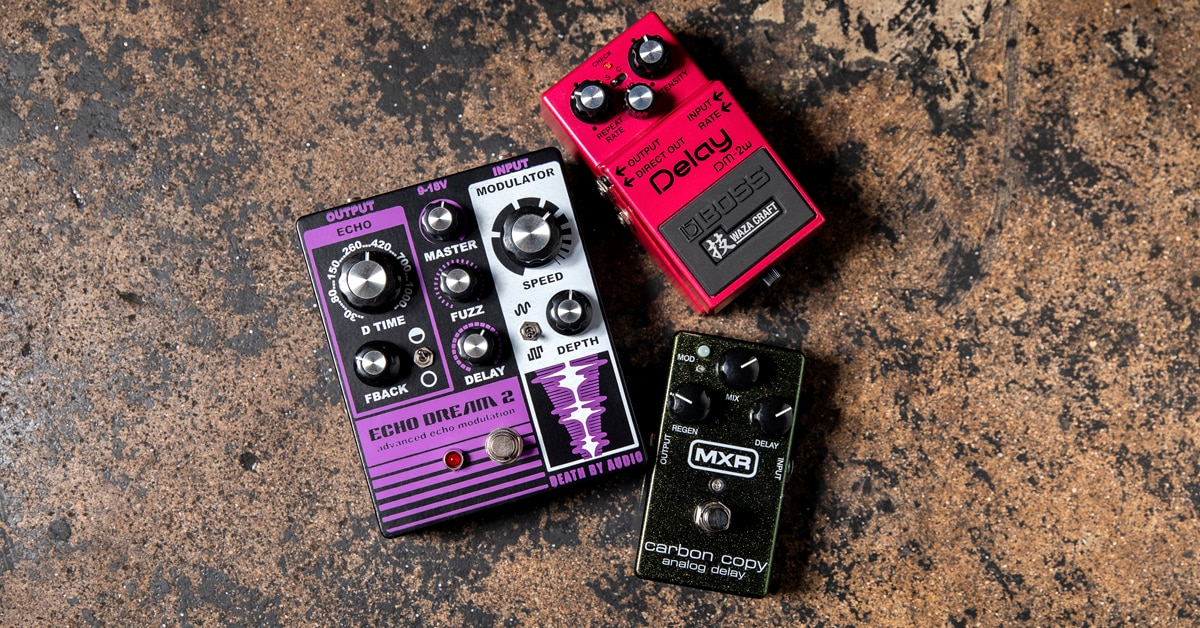Delay is one of the most versatile effects in a guitarist's arsenal. With just a few small adjustments, your sound can swing from a simple repeated note to modulated rhythmic cascades and on into endless, feedback-drenched canyons of sound.
Ok, so what is it? Essentially, it’s a sound you’ve played repeated after a short interval, much like an echo. With a delay pedal, you can adjust the length of time before the repeat, as well as the number, decay and volume of those repeats. That’s the foundation.
From the tight slapback echo of early rockabilly and surf hits to the seemingly endless syncopated repeats U2’s Edge used on The Joshua Tree, the breadth of sounds you can achieve with delay and a little creativity is incredible.
On “Welcome to the Jungle,” Slash used delay to craft that iconic intro, with his riff bouncing back at around 150 milliseconds. David Gilmour combined two delay pedals for the spooky, metallic repeats he achieved on “Run Like Hell.”
The spacey, psychedelic potential of delay can be heard on Eddie Hazel’s sprawling, interstellar solo on the Funkadelic track “Maggot Brain.” Here, delay achieves the effect of a second player following just a beat behind, mirroring a series of increasingly complex patterns.
Feedback and self-oscillation are important in delay evolution and experimentation. As the delay itself becomes oversaturated and repeats back upon itself, it can achieve a feedback loop that builds in intensity and insanity. Radiohead’s “Karma Police” is a perfect example of conventional use of self-oscillation, and it’s an effect favored by psychedelic and acid rockers.
Producer and guitarist Daniel Lanois, who produced U2’s The Joshua Tree, is a famed maestro of delay, using it in his solo work, as well as on tracks like “Where Will I Be” by Emmylou Harris, where he achieves a pulsing, dreamlike, reverb-drenched sound guitarists still try to imitate.
Today, artists like Adam Granduciel of The War on Drugs, deploy delay and oceans of reverb to magnificent, otherworldly effect, as heard on tracks like “Strangest Thing”, from their Grammy Award-winning album A Deeper Understanding.
Table of Contents
A Quick History of Delay
Comparing the Top Delay Pedals
The Best Delay Pedals of 2025
Dunlop Echoplex Delay
BOSS DM-2W Delay
JHS 3-Series Delay
Old Blood Noise Endeavors Black Fountain V3
MXR M169 Carbon Copy
Electro-Harmonix Deluxe Memory Man
Universal Audio Starlight Echo Station
BOSS DD-500
Keeley ECCOS
Walrus Audio ARP-87
Death By Audio Echo Dream 2
BOSS RE-202 Space Echo
Strymon TimeLine
Line 6 25th Anniversary DL4 MkII
Choosing The Best Delay For You
A Quick History of Delay
Great players have made the most of delay for more than half a century now. The legendary Sam Philips of Sun Studios used a pair of tape machines to create a slapback echo made famous on Elvis Presley’s “Blue Moon of Kentucky” and a host of early rockabilly and southern blues records. This was a tight delay, almost like an echo off a reflective surface just a few feet away, or like the bounce-back off of buildings at an outdoor concert in the city.
The earliest delay effects were simple tape loops, with a signal recorded to a length of tape and the delay achieved by changing the tape speed or distance between play and record heads. Visionary studio engineers and players like Les Paul and Chet Atkins found a wealth of uses for this early effect, from quick slapback echoes to layers of texture.
In 1959, engineer Mike Battle sought to build a portable version of the built-in tape echo on the EchoSonic guitar amp created by Ray Butts. Battle’s creation was the Maestro Echoplex, which would become the grandaddy of all delays.
The Echoplex tape delay was hugely versatile, thanks to a movable tape head that allowed players to change the timing of the delay. Beloved by Jimmy Page, Brian May, David Gilmour, Eddie Van Halen, Eric Johnson, Ace Frehley and many more, the Echoplex ruled the delay world for decades.
Though the ’60s were dominated by the Echoplex, other major players entered the scene. The Italian Binson Echorec was a favorite delay of most of Pink Floyd, with David Gilmour, Syd Barrett, Roger Waters and even keyboardist Richard Wright using it on recordings like “Interstellar Overdrive” and “Shine On You Crazy Diamond.”
In 1973, Roland released the Space Echo, and changed the delay landscape forever. This was a tape delay that benefited from a gorgeous spring reverb that inspired guitarists and keyboardists alike to experiment with lush, expansive sounds. The Space Echo quickly found favor in the emerging dub scene. Musicians and producers, like King Tubby and Lee "Scratch" Perry, played it like an instrument, using it on everything from vocals to drums to melodicas. Today, the Space Echo is considered a pillar of dub's loose, laid-back sound.
By the mid-1970s, delay graduated from tape to the bucket brigade circuit realm, with small capacitors storing and moving the signal along, making a more precise and durable effect. The earliest of these delay pedals were the Electro-Harmonix Memory Man, released circa 1976, and the Dynacord EC 280, released circa 1977. The Memory Man, in its many incarnations, is a favorite for its simplicity and flexibility.
In the 1980s, microchips claimed delay, adding a wealth of optionality and also migrating from the floor to rackmounts. The Edge favored the Memory Man pedal in U2’s early days, but he moved to the Korg SDD-3000 rackmounted delay for The Joshua Tree. These digital delays expanded the possibilities of pitch modulation, delay time and feedback, and programming.
After the rackmount honeymoon phase was over, guitarists again began to crave the ease of pedals. In 1984, BOSS met that need with the DD-2 digital delay pedal, packing a rack effect’s worth of goodness into a stompbox.
An issue with the rackmounts was that they were complicated to operate—particularly mid-performance. Returning the effect to the pedal made it simpler to operate and more player-friendly. From the BOSS Pitch Shifter Delay to the MXR Carbon Copy, the ’90s and 2000s ushered in a new era of portable, rugged stompers.
The boutique pedal revolution brought us an embarrassment of riches in delay sounds and options. BOSS, Keeley Electronics, JHS, Walrus Audio and more continue to create delays that both capture the classics and explore brave new sounds.
Today, we have the best of all delay worlds laid out quite literally at our feet.
Comparing the Top Delay Pedals
|
Pedal Name |
Tonal Characteristics |
Power Draw |
Total Voicings |
|
Hi-fi, all-analog echo with "Age" simulation |
9V DC, 75mA |
1 |
|
|
Classic bucket brigade warmth with expanded delay |
9V DC, 35mA |
2 |
|
|
Digital clarity and analog warmth, switchable |
9V DC, 71mA |
2 |
|
|
Dark, haunting, oil can delay emulation |
9V DC, 110mA |
3 |
|
|
From snappy to sophisticated, larger-than-life opulence |
9V DC, 26mA |
2 |
|
|
Rich, analog delay with chorus and vibrato effects |
24V DC, 45mA |
1 |
|
|
Ultraprecise modeling of classic echoes |
9V DC, 400mA |
3 |
|
|
Authentic Roland/BOSS emulations running the gamut of tonality and modulation |
9V DC, 200mA |
12 |
|
|
Tape echo emulation with looper and flanged modulation |
9V DC, 146mA |
3 |
|
|
Lo-fi, warped, warm and murky |
9V DC, 100mA |
4 |
|
|
Delay and fuzz controls, from warbly and gruesome to contorted and crushing |
9V DC, 60mA |
2 |
|
|
Famous, vintage-style tape echo |
9V DC, 140mA |
12 |
|
|
Studio-class digital delay with deep editing and presets |
9V DC, 300mA |
12 |
|
|
Chameleonic digitally modeled delays with both old- and new-school charm |
9V DC, 300mA |
30 |
The Best Delay Pedals of 2025
Dunlop Echoplex Delay
Why You Want to Buy It: This beloved pedal simulates the coveted tape echo tones of the legendary Echoplex EP-3 unit, plus a clever “Age” knob to simulate time-weathered tape.
Things to Consider:
- Captures the sound of aging, decaying tape for vintage-style echo
- Offers tap tempo control for precise delay time adjustments
- Supports stereo operation with a TRS cable
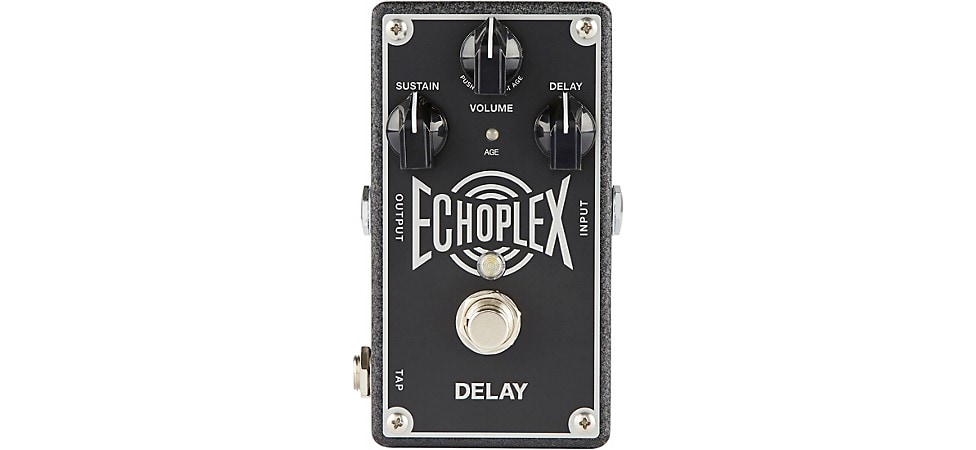
Pictured: Dunlop Echoplex
One of the most beautiful sonic aspects to those grand old tape delays lies in the tape itself. Tape ages, stretches and decays, and all of that colors your sound.
Dunlop kept that in mind when designing the gorgeous Dunlop Echoplex pedal, a tribute to the third-generation solid-state version of the effect that defined delay for generations. With modes that digitally “age” your delay, this pedal simulates the sound of aging, decaying tape. The result is a delay that ranges from clean and crisp to dirty, dark and modulated, simulating the flutter and wow of a vintage machine. And its self-oscillation possibilities range from muffled roars to piercing wails.
While it pays tribute to the classics, it’s also bursting with very modern features, including up to four seconds of delay through the tap feature, and TRS cable connectivity for stereo operation. This rugged little box carries all the swagger and versatility of its big, expensive forebears.
BOSS DM-2W Delay
Why You Want to Buy It: Waza Craft-built luxurious analog delay offers a faithful recreation of the classic DM-2 tone with expanded capabilities.
Things to Consider:
- Custom mode offers over twice the delay time of the original; Standard mode yields authentic DM-2 tone and delay time
- Bucket brigade circuitry for warm, enveloping echoes
- Equipped with delay out, as well as direct out for routing dry signal to a separate amp
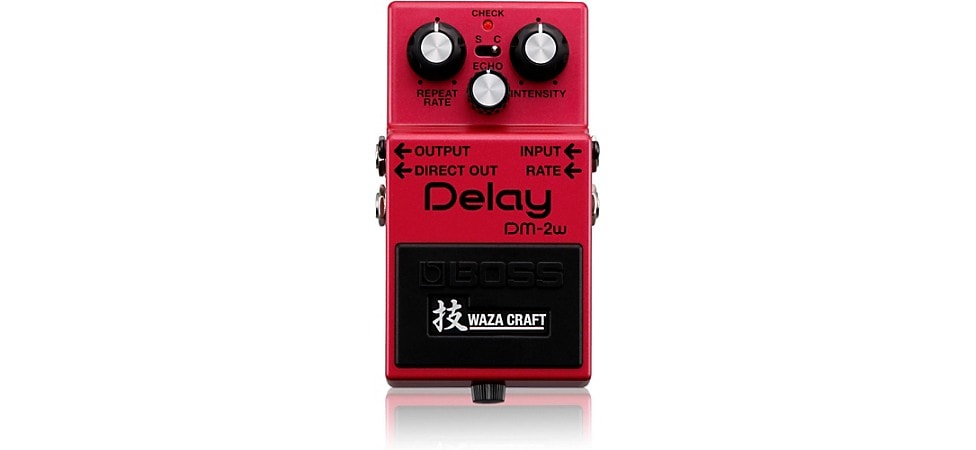
Pictured: BOSS DM-2W Waza Craft
Waza Craft pedals are luxury-model BOSS pedals, crafted not only to painstakingly recreate classic pedals, but also expand upon them. The BOSS DM-2W is a standout example. Based on the coveted original DM-2 bucket brigade delay, this pedal recreates it and adds a custom mode with more than twice the delay time of the original, from 400 to 800 ms.
How does this style of analog delay sound compared to the Echoplex?
While tape delay sound degradation is romanticized, there’s much to be said for the way bucket brigade circuit technology treats a repeated signal. As the circuitry repeats the sampled sound, it degrades with each successive echo. This creates an incredibly warm and dark-sounding decay, and the DM-2W has that by the pound.
JHS 3-Series Delay
Why You Want to Buy It: Provides clear digital delay and gritty analog sounds in a straightforward and affordable package.
Things to Consider:
- Minimalist 3-knob, 1-switch design offers easy operation at the expense of parameter tweakability
- Two distinct delay voices for versatile tone shaping
- Robust USA build quality in a standard-sized form factor
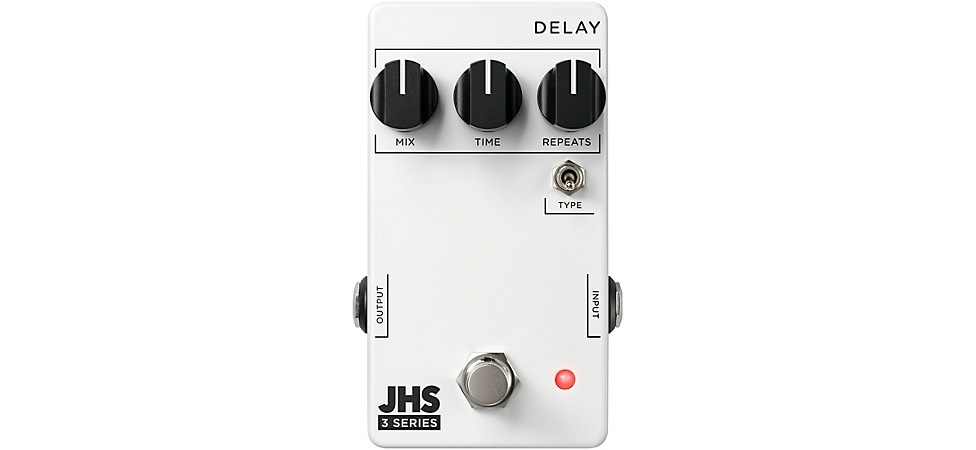
Pictured: JHS 3-Series Delay
The JHS mad scientists in Kansas City have created the affordable JHS 3-Series Delay. This minimalist beauty may look simple, but it packs two unique delay voices into its tidy package. One setting provides crystal-clear digital delay, and the other emulates bucket brigade analog delay with grit and warmth. Having these two options in one easy box gives you the opportunity to range from ‘80s-style crystalline delay to the gritty depth indie rock sound with the flip of a switch and at a sub-$100 pricepoint, it may be the best budget delay pedal on this list.
Old Blood Noise Endeavors Black Fountain V3
Why You Want to Buy It: This echo pedal delivers an innovative emulation of the rare and hypnotic oil can delay effect, with additional vibrato and phasing.
Things to Consider:
- Expression input lets you externally manipulate Time and/or Feedback
- Three different modes for creative delay sounds, plus tap tempo
- Capable of self-oscillation for experimental musicians
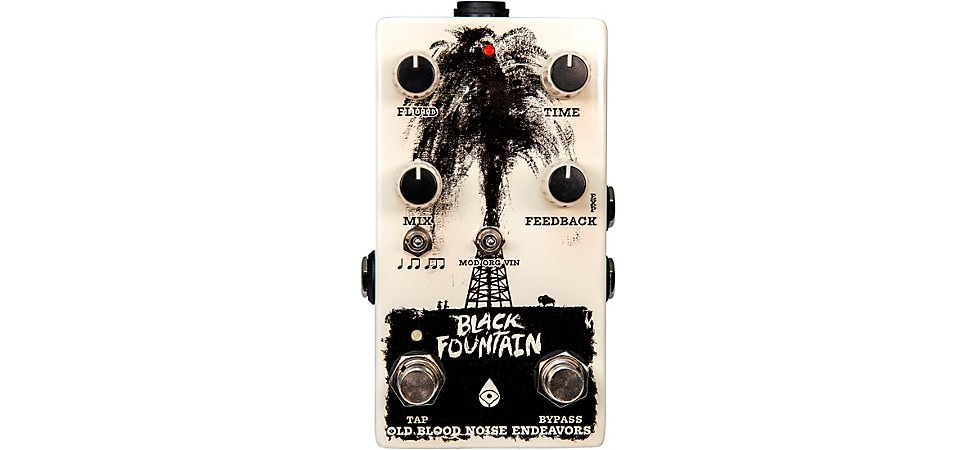
Pictured: Old Blood Noise Endeavors Black Fountain V3
Let’s take a step into the boutique world and look at the astounding Old Blood Noise Endeavors Black Fountain V3.
Something we didn’t touch on earlier in our little history lesson is oil can delay. This was a method developed in the early days of delay, alongside tape delay. With this method, circular containers of oil were used to create a delay effect through the oil’s electrostatic qualities. As the can was spun, the oil sloshed around and created a swooping, wet delay. Ry Cooder was a master of using this effect.
Old Blood Noise gives us a stunning recreation of this dizzying, hypnotic effect with a “fluid” knob that controls the amount of warbling liquid sound you get. This pedal’s sound is dark and haunting, and can range from something closer to a simple vibrato all the way to one-second repeats. This is an ideal pedal for spooky vintage western or southern gothic vibes, as well as ambient musicians and anyone in need of a rare, warbling effect.
It features three modes, Modern, Vintage and Organ. Organ mode has a fixed delay time of 200 ms, and the time control allows you to adjust the rate of modulation. If you’re a fan of delay feedback, this handsome pedal delivers. Simply hold the tap tempo button and you’ll maximize feedback to apocalyptic levels.
MXR M169 Carbon Copy
Why You Want to Buy It: It provides an all-analog audio path for rich, warm delays, enhanced by a mod switch for additional width and rate control.
Things to Consider:
- Provides up to 550ms of analog delay with chorus and vibrato
- 3-knob, 1-Mod button design is simple yet limitlessly resourceful
- Internal trim pots to fine-tune the modulation depth

Pictured: MXR M169 Carbon Copy Analog Delay
Since its release in 2008, the MXR Carbon Copy has been a best-selling pedal, and for good reason. The M169 is a rugged analog stompbox that makes the most of up to 600 ms of bucket brigade delay for a dark, warm effect perfect for any genre of music. It includes modulation with internal trim pots to adjust the width and rate of modulation to reach nearly flanger levels of sweep. With 76 reviews, averaging 4.78 stars, the MXR Carbon Copy is our top-reviewed delay pedal on this list.
Today, the Carbon Copy is also available in Mini and Deluxe form. The Carbon Copy Mini packs as much punch as the original, in a smaller footprint, while the Carbon Copy Deluxe doubles the delay time (1,200ms) and adds tap tempo, input for an expression pedal and further tone tweaking controls.
Electro-Harmonix Deluxe Memory Man
Why You Want to Buy It: This stands as one of the most versatile analog delay pedals available, dishing out flush modulation options and a distinctively warm echo in a minimalist design.
Things to Consider:
- With its vibrant analog warmth, it’s a power guzzler, at 24V, 45mA
- Large footprint may require some pedalboard planning
- Loaded with effect and direct outs, as well as true bypass
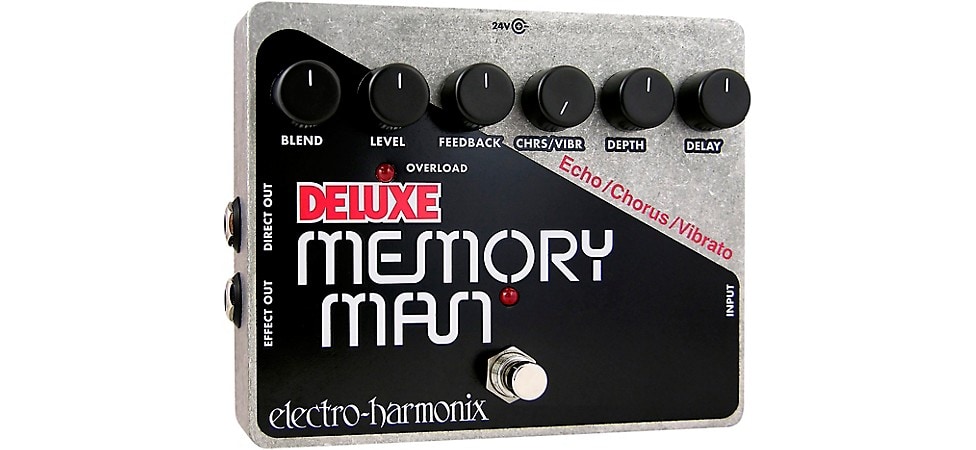
Pictured: Electro-Harmonix Deluxe Memory Man Analog Delay
The Electro-Harmonix Memory Man has had many incarnations over its long and distinguished existence, dating back to its first foray into the delay pedal market in 1976. The Deluxe Memory Man, released circa 1980 as the fifth Memory Man iteration, delivers incredible depth, massive chorus and shimmery vibrato. With up to 550 ms of analog delay time, the EHX Deluxe Memory Man is one of the best delay pedals on the market.
Sweep the delay and feedback controls as you play, and you’ll get whooshing modulation with swelling, otherworldly walls of sound. The chorus/vibrato control also introduces a pitch-shifting modulation. And while this pedal is built with the same analog circuitry as the original for perfect vintage sound, it also features the distinctly modern feature of true bypass to keep your signal unchanged when the pedal’s not engaged.
While it is the priciest of the three BBD-based pedals in our rundown, its wide range of tone tweaking and legendary status make it the best analog delay pedal on this list.
Need to save a little space on your pedalboard? Check out the Deluxe Memory Man Nano, released in October of 2021.
Universal Audio Starlight Echo Station
Why You Want to Buy It: Packs a trio of iconic delay effects into one next-gen, dual-engine unit with archetypically legendary UA build quality and sonic fidelity.
Things to Consider:
- Precision modeling captures classic delay sounds
- USB functionality for future updates and deep customization
- Top-mounted in/out and power jacks for easy routing on otherwise tight-fitting boards
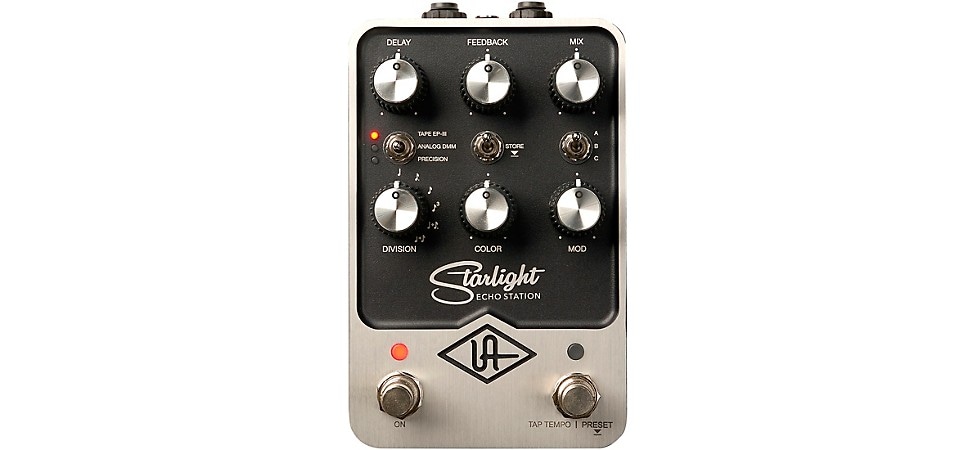
Pictured: Universal Audio Starlight Echo Station
The Universal Audio Starlight is truly stellar. It packs three robust delay effects into one box, with the EP-III and Analog DMM replicating two of the most sought-after delays in history (the Maestro Echoplex EP-3 and the Electo-Harmonix Deluxe Memory Man, respectively), and UA’s own Precision Digital Delay rounding out the distinguished company.
UA’s precision modeling heritage is on full display here. The Starlight Echo Station models the equally famous preamps from those sought-after delays for a compelling representation of the round, warm vintage sounds. Also, this modern take on the classics boasts USB functionality for software updates, plus multiple modulation modes for adding even more character to your sound.
BOSS DD-500
Why You Want to Buy It: A certified beast of an effects pedal, it delivers a wide range of Roland/BOSS delay options with a user-friendly interface and deep programmability.
Things to Consider:
- Vast selection of delay types, built-in looper and screen menu
- High-quality emulations of classic Roland and BOSS delays
- Large footprint with a moderate 9V, 200mA power draw
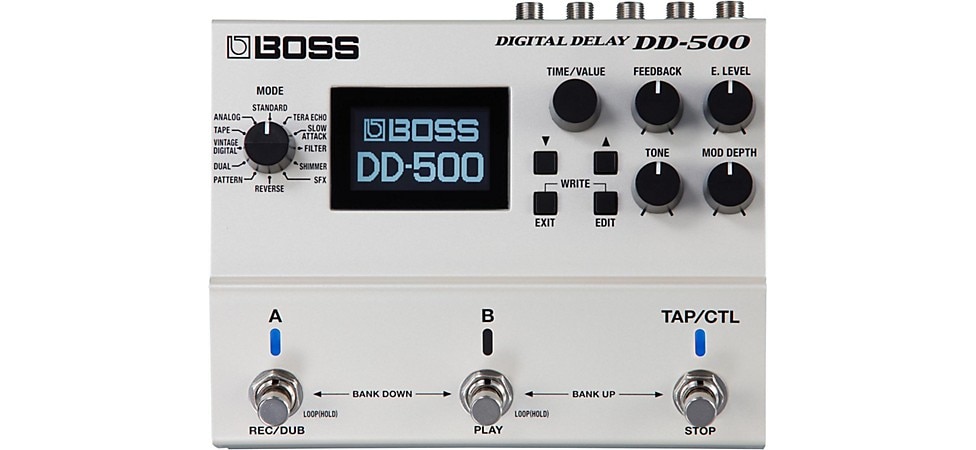
Pictured: BOSS DD-500
Time and again, BOSS shows up at the vanguard of pedal innovation. The DD-500 is no exception. With unbelievable modern optionality and a vintage setting that captures the trusty DD-2, this is a powerful effects station.
Pedals with this range of versatility are often confusing to operate, but the DD-500 breaks everything down into simple steps. The control knobs provide direct access to the most important features, while the LCD display unlocks the detailed steps to shaping your desired individual effect. It also features a 120-second looper and authentic models of classic Roland and BOSS effects, including the DM-2, RE-201, SDE-3000 and Tera Echo, plus models of other coveted delays.
Keeley ECCOS
Why You Want to Buy It: A true tape delay emulation, this cutting-edge stomp offers studio-quality delay, looper functionality and extensive connectivity options for making the most out of its potential.
Things to Consider:
- Comprehensive I/O—stereo in/out, as well as expression pedal and tap/remote jacks
- Features three memory presets for saving settings
- Remarkably extensive control on a standard-sized pedal
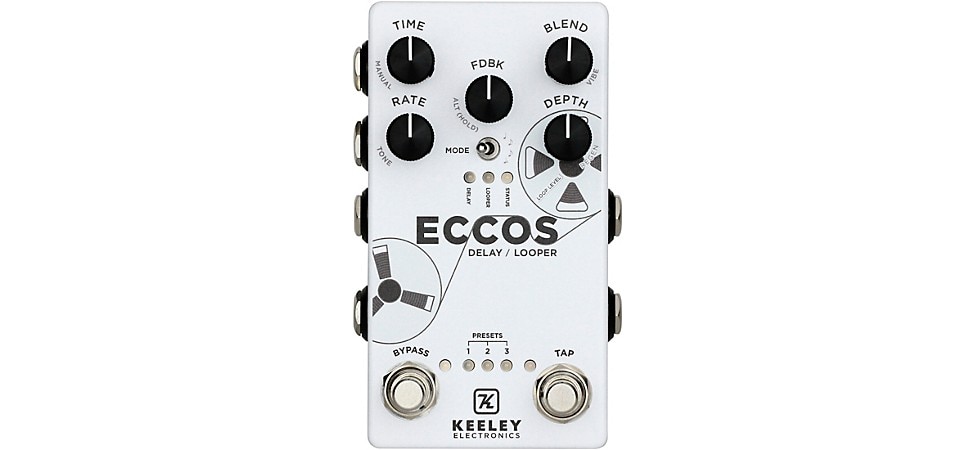
Pictured: Keeley ECCOS Delay and Looper
This boutique beauty is a love letter to tape technology. It’s a combination looper and delay pedal, and is engineered to deliver tape-worthy vintage sound. Modulate pitch as you adjust delay time, just as a tape would when speeding up and slowing down, and apply flange to your delay for whooshing modulation.
The Keeley ECCOS is so robust, and has such a strong sonic personality, that it’s a pedal you play off of, much the way you would another guitarist. The looper effect allows you to record, play, reverse or play at half speed, and provides up to two minutes of loop time.
Also, holding the tap tempo switch delivers endless feedback. There’s nearly no limit to the amount of features on this sleek pedal, including three memory presets, infinite overdubbing and stereo output.
Walrus Audio ARP-87
Why You Want to Buy It: Compact and versatile, this pedal features multiple delay algorithms with a broad range of adjustable parameters.
Things to Consider:
- Four unique delay types including analog, digital, lo-fi and slapback
- Global low-pass filter for tonal shaping
- Like all their pedals, Walrus Audio recommends using an isolated power supply
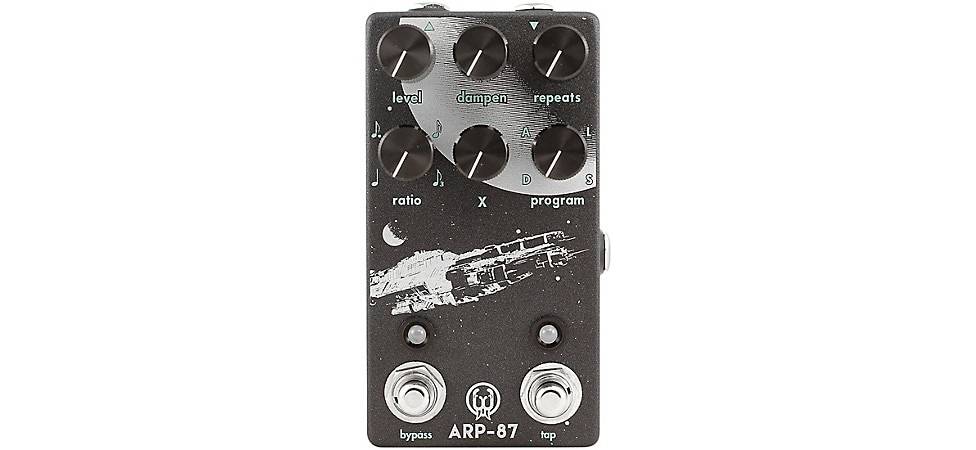
Pictured: Walrus Audio ARP-87 Multi-Function Delay
When it comes to versatility, innovation and sheer wow factor, this lil’ Walrus can’t be beat. The Walrus Audio ARP-87 is built with four delay algorithms: analog, lo-fi, digital and good old slapback. A global low-pass filter called Dampen gives you a master tone control for your delay, and the X control adjusts specific parameters within each delay algorithm, such as filter width in the lo-fi delay.
The ARP-87 also features a Trails/No Trails mode. In Trails mode, the delay trails die down gradually when you turn the pedal off, while No Trails kills the delay abruptly when you power off—highly useful for sudden shifts to chorus or a quiet verse, or for letting your delay bleed over into a quiet section or silence.
Death By Audio Echo Dream 2
Why You Want to Buy It: This box combines intense delay effects with a fuzz circuit, providing a range of sounds from traditional echoes to chaotic, sonic landscapes.
Things to Consider:
- Larger than the standard pedal, but with a light power draw
- Modulation with adjustable rate and depth for added sonic variety
- Toggle switch changes modulation waveform for different textures
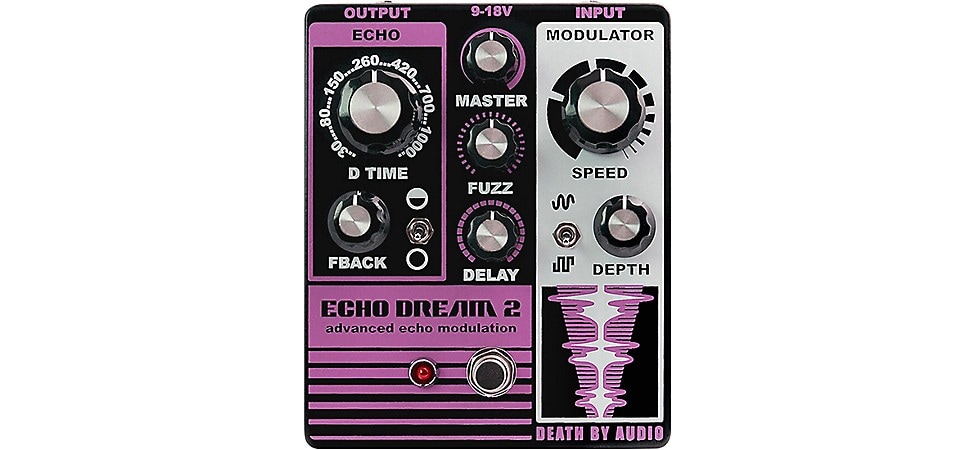
Pictured: Death By Audio Echo Dream 2
The Echo Dream 2, with its vintage good looks and aggressive features, delivers a combination of delay and fuzz worthy of the loudest shoegazer greats and the most out-there ambient alchemists.
With both fuzz and delay engaged, adjusting the modulation depth can bring to life pitchy weirdness ranging from fat and rubbery to piercing and glassy. The added bonus of a switch that toggles from modulator waveforms to sharper square waves provides a defined difference in the swoop of modulation, from gradual to harsh. Simple to control, but complex in its output, this is a dream stompbox for guitarists pushing the limits of their sound.
BOSS RE-202 Space Echo
Why You Want to Buy It: Experience the iconic sound of the classic tape echo in a modern, compact form factor.
Things to Consider:
- Requires 300mA due to its high-fidelity processing and expansive feature set
- Larger than most of the other delay pedals on this list
- Offers extensive tweakability with a user-friendly interface
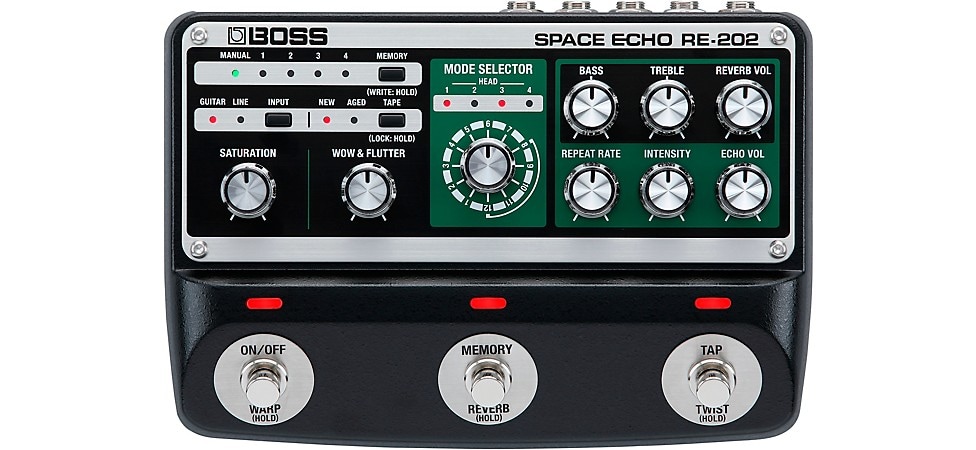
Pictured: BOSS RE-202 Space Echo
The BOSS RE-202 Space Echo pedal is a digital powerhouse that revives the legendary RE-201 Space Echo tape delay with stunning accuracy. BOSS engineers have meticulously recreated the tape flutter and magnetic head sound saturation to produce a delay that's as soulful as it is dynamic. The tap tempo function allows for precise delay timing, while stereo inputs and outputs provide expansive soundscaping possibilities. With the RE-202, the spirit of the original is honored, yet it's packed with contemporary features that modern players will appreciate.
The pedal's robust build and the thoughtful design echo BOSS's tradition of thoughtfully engineering quality and user-friendly interfaces. This Space Echo delivers an intuitive experience with a rich feature set, including the ability to tweak echo intensity, repeat rate and more. The RE-202 doesn't just echo the past—it brings it forward, integrating vintage sound into modern musical expression.
If you're looking for classic Space Echo sounds in a smaller package, check out the equally impressive BOSS RE-2.
Strymon TimeLine
Why You Want to Buy It: True to Strymon’s forward-thinking reputation, this powerful delay lets you explore new dimensions of sound with matchless modulation flexibility.
Things to Consider:
- High-fidelity processing ensures unmatched sound quality
- Vast feature set comes at a considerable size and power draw
- An expansive array of parameters for comprehensive control over the delay characteristics
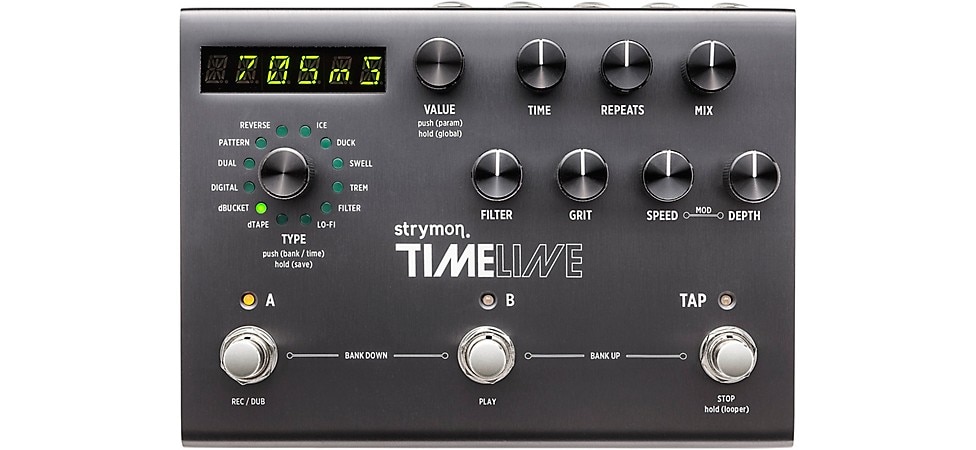
Pictured: Strymon TimeLine Multi-Delay
The Strymon TimeLine delay is not just a pedal—it's an expansive canvas offering a staggering array of delay machines, each with a level of depth that can transform simple echoes into complex rhythmic patterns or ambient washes. Offering 12 different delay types, the TimeLine pedal is capable of replicating vintage gear's soulful decays and modern delay's precision. It's a staple on the pedalboards of guitarists who demand nothing less than auditory excellence, and its considerable power draw is a small price to pay for its breadth of soundscaping capabilities.
Line 6 25th Anniversary DL4 MkII
Why You Want to Buy It: One of the earliest digital modeling effects units of its kind, the Line 6 DL4, with its characteristic footprint and embedded looper functionality, is versatile, easy to use and representative of a pivotal era in early ’00s rock and indie.
Things to Consider:
- XLR input to process vocals or any miked source
- Up to 240 seconds of looping time, expandable to several hours with optional microSD card
- MIDI in and out/thru, as well as expression pedal and footswitch inputs

Pictured: Line 6 25th Anniversary DL4 MkII
The iconic Line 6 DL4 celebrates two and a half decades of digital delay dominance with a limited-edition anniversary pedal. Sharing an identical knob and footswitch layout as the original green box, this hand-numbered, collectible 25th Anniversary DL4 MkII comes in a special silver finish with a vintage logo and is limited to 2,500 units worldwide.
Sonically, Line 6’s DL4 MkII contains a whopping 30 delays—15 cutting-edge models derived from renowned HX processing, 14 timeless sounds maintained from the first pedal and an Echo Platter setting pulled from the brand’s rackmount Echo Pro. There are also 15 “secret” reverbs accessed by holding and turning the Legacy button, offering even more ways to drench your signal and shape a soundscape all your own. Plus, initially lauded for its 14-second looper upon debut in 1999, the Line 6 DL4 MkII now comes loaded with four minutes of memory for your wildest experimentations. Packing all of that processing power into one box, the DL4 MkII is far and away the most versatile delay pedal on this list. Be sure to check out our interview with Line 6’s chief product design architect, Eric Klein, for a behind-the-scenes peek at the development of the DL4 MkII.
Throughout time, the omnipresent DL4 has had a home on the pedalboards of Radiohead's Thom Yorke and Ed O’Brien, Pearl Jam's Mike McCready and Stone Gossard, Oasis' Noel Gallagher and Gem Archer, John Frusciante and St. Vincent, to name a few. Dave Knudson of Minus the Bear is regarded for employing four Line 6 digital delay units, developing a loop-centric indie sound, which, at the time, was considered lightyears ahead of the game. Today, the limited-edition 25th Anniversary Line 6 DL4 MkII commemorates one of the most quietly influential effects pedals ever made.
Choosing The Best Delay Pedal For You
Finding the best delay pedal for you comes down to your needs. Is this an added flavor in your sound, or will delay and all its modulation and sonic possibilities be a driving force in the music you make? Are you using if for your guitar, your synth or as a studio multitasker?
Your ears are the best judge. Head down to a Guitar Center and take a few of these for a test drive. There’s a delay pedal out there with the sound, features and price tag that’s right for you.




